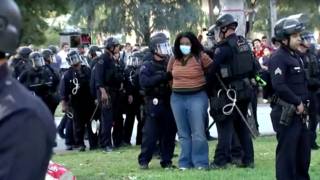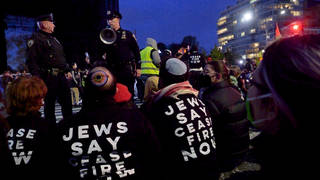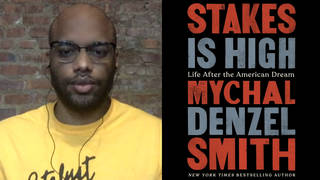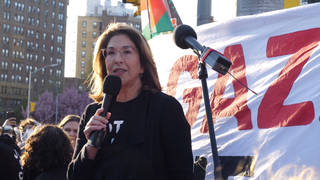
Related
Guests
- Marc Lamont Hilljournalist, distinguished professor of African American studies at Morehouse College and author of Nobody: Casualties of America’s War on the Vulnerable, from Ferguson to Flint and Beyond.
Marc Lamont Hill, journalist, distinguished professor of African American studies at Morehouse College, responds to calls by Republican presidential candidate Donald Trump to expand the controversial police tactic of stop-and-frisk in order to reduce crime. “We keep adding more hay to the stack … more people to stop-and-frisk to find nothing,” Hill says. He argues a range of factors have caused crime to go down already, and concludes: “We can’t arrest our way out of a problem of state violence.”
Transcript
AMY GOODMAN: Right before we break, I want to bring in what Republican presidential candidate Donald Trump responded to a question about violence in the black community during a town hall meeting in a black church in Cleveland hosted by Fox News.
RICARDO SIMMS: There’s been a lot of violence in the black community. I want to know what would you do to help stop that violence, you know, black-on-black crime.
DONALD TRUMP: Right. Well, one of the things I’d do, Ricardo, is I would do stop-and-frisk. I think you have to. We did it in New York. It worked incredibly well. And you have to be proactive.
AMY GOODMAN: There you have Donald Trump’s response. Before we wrap up, tonight 100 million people are expected to watch the first presidential debate. Can you talk about, first, his response, and what you want to hear him and Hillary Clinton have to say on these issues?
MARC LAMONT HILL: I think Donald Trump has made his position very clear. At the convention in August—or in July, rather, and also last week, he has repeatedly said that more police officers work, more arrests work, stop-and-frisk works, broken windows policing works. That’s his approach. I hope that Hillary Clinton—since we can’t have fact-checking moderators anymore, I’m hoping that Hillary Clinton can say, “Look, this just untrue.”
Stop-and-frisk didn’t—it didn’t work unless your goal is to stop black people from smoking weed. Most people who were stopped were black. Most people didn’t have any guns or drugs, and those who did had small amounts of marijuana. We’ve essentially tried to find a needle in a haystack, and we keep adding more hay to the stack, right? We just keep adding more people to stop and frisk, to find nothing. Broken windows policing, this whole narrative that it worked is empirically untrue. There are states where—that did not deploy broken windows policing and still managed to have crime reductions.
Also, it’s a very messy mixture of things, from the rise of CompStat in New York, which is a more advanced method of investigation, the sort of 20-year spread of—or reduction of lead in gasoline and in paint. All these things, kind of environmental factors, there are a range of things that caused crime to go down, not stop-and-frisk and not broken windows policing, which has never been deployed in the way that it was intended. So, I think Donald Trump’s narrative itself is wrong, and his approach is wrong. He’s essentially saying we can arrest our way out of this problem. And we can’t arrest our way out of a problem of state violence.
AMY GOODMAN: In North Carolina, it’s an open-carry state. Who does that apply to?
MARC LAMONT HILL: Gun laws have never applied to the vulnerable. They’ve never applied to black people. They’ve never applied to poor people. They’ve never applied to Latinos. Maybe on paper they have, but as a practical matter they have not. As soon as black people were freed, there’s been attempt to disarm them. As soon as black people have been freed from the sort of legal restrictions in places like Illinois and in the South, as well, there have been attempts to say, “Hey, we need to—we need to keep a grip on these people in terms of gun access.” We’ve always tried to disarm black people. And so, as a practical matter, going through the world, because black people are read as criminal, the assumption is if a black person has a gun, then they probably don’t have a legal weapon. They’ve lost their right because they’re a felon. They are about to commit an act of crime, even if they’re just walking down the street.
Now, people will say, well, in this case, this guy did lose his right to access a weapon, because in 2005 he had a felony conviction. That is in fact true. However, the police didn’t know that. They didn’t run a rap sheet before they ran up on this car. They had no idea who this man was. They assumed who and what he was, because of that. And that plays into the mix with Alton Sterling, with Philando Castile. After the fact, they say, “Oh, this person had a permit; this person didn’t. This person was a criminal; this person wasn’t.” In the moment, the police knew nothing except this was a person in his car minding his own business, not bothering anybody, armed really only—that we know for sure—with some weed. And everything I know about weed, both from my empirical investigation and from reading about it, is that weed doesn’t charge people up and make them want to go shoot police. If anything, it makes them want to eat some nachos. So, if it were up to me, they would have stepped back and engaged differently.
And that’s the last piece of this, Amy. We have to have a different tactical approach. If this guy is really sitting in a car with a gun, why do you want to bash the window in? Why do you want to encroach so quickly? The same thing with Tamir Rice in Cleveland, right? The kid’s standing outside. If he is allegedly holding a gun, why do you roll up two feet from him and jump out and start shooting within milliseconds?
AMY GOODMAN: Another open-carry state, by the way.
MARC LAMONT HILL: Another open-carry state, again. And they thought he was 20, even though he was 12. So, again, there is this narrative that the police did all they could to protect themselves, but tactically it doesn’t make sense, reasonably it doesn’t make sense. The narrative is implausible, and yet we keep believing it because it’s black bodies. We have to have a different approach.
AMY GOODMAN: Marc Lamont Hill, I want to thank you for being with us, journalist and distinguished professor of African American studies at Morehouse College. His book, Nobody: Casualties of America’s War on the Vulnerable, from Ferguson to Flint and Beyond.
When we come back, a Democracy Now! exclusive. Stay with us.












Media Options